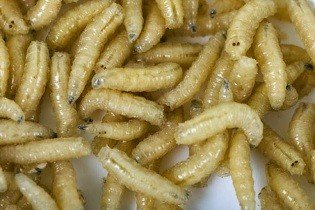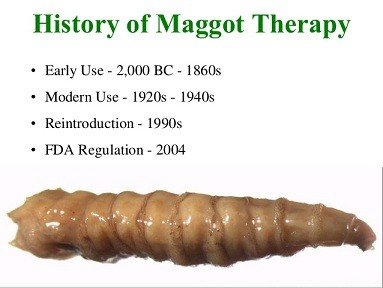Maggots have been known to be associated with filth, and dwell among rotten and decaying matter; but do you know that maggots have therapeutic uses in the field of medicine? Join me as we take a little survey.

Maggots (Phaenicia sericata), as we know, are the larva of a creature we don't probably like to see around too; which is the "housefly".
In nature, flies do lay their eggs in rotten materials, so the hatchlings (the maggot) would not need to go far to look for food. They feed on the decomposing matter. "source"
This property of maggot; to feed on decaying and decomposing matter, is what has given them a perfect use in the field of medicine.
One of the major advances in this kind of therapy has been seen in Wesley Medical Centre For Wound Healing. Here's a real life scenario:
Cindy Kennedy, a diabetic patient, had an exteriorized abscess in her abdomen, which left a massive wound in her lower abdomen. According to her, traditional and conventional therapy caused her so much pain and had left little or no impact. When she was brought to Wesley Medical Centre, maggot therapy was introduced to her, and over 700 live maggots were introduced into the affected part. And in few days, the wound showed amazing improvement.
The secret behind this is embedded in the feeding mechanism of maggots. Once they are introduced, they will selectively eat up the dead flesh, leaving the healthy flesh and tissue unharmed. Fascinating, isn't it?

Benefits of maggots in wound healing
- Disinfection: Not only do maggots eat up the debris from wound (debridement), but it has been proven that their saliva has antibacterial and antibiotic effect on wounds. So, as they are eating up the dead tissues that would provide breeding ground for bacteria, their saliva would clean out the bacteria too. "Thanks to maggot" Lol.
- Speeds up the healing process: A research that was done by NHS tried to compare the rate of wound healing when maggots were introduced. It was revealed that the introduction of maggots reduces the duration from 89days to just 5days. This is really awesome.
- Saves cost: In the same research by NHS, it was also revealed that maggot therapy would stop the spread of Methicillin-Resistant Staphylococcus Aureus (MRSA), thus saving the world economy billions in US Dollars.
Note: Maggot therapy has been around since the medieval period, but advances are being made to make them more enhanced in the treatment of wound.
Maggot has also been proved useful in the healing of post-operative wounds, and some forms of pressure ulcers.
No wonder the U.S Food and Drug Administration (FDA) approved maggots to be used for the treatment of wounds in the year 2004.

Requirements for maggots therapy
Even though this therapy is very potent, there are some precautions that should be taken when introducing them to wound. Here are some of the requirements:
- Before introducing maggot therapy, the wound must be moist and exudate, with an adequate supply of oxygen. Maggot therapy does not work well on dry wounds (because they lack the oxygen required for maggots to thrive).
- In the case of dry wound; before the introduction of maggots, the affected area should be treated with a saline solution for about 2 days.
Once the maggots are introduced, a special dressing would prevent them from escaping, while providing a free flow of air to the wound.
Reservations of maggot therapy
The major reservation of this therapy is the acceptance within the human community. A lot of convincing will have to be done to make people welcome this idea the more.
Carrying maggots about isn't a very good option to choose from :)
But the therapy is just for a few days, after which the maggots will be removed.
Next time you see a maggot, just show some respect. These guys are saving lives :)
Thanks for reading
References for further reading: Ref1, Ref2, Ref3, Ref4


